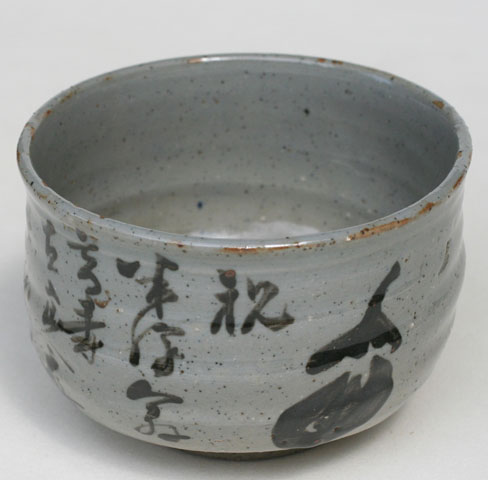cha-no-yu
Chawan, tea bowl - Nasu, AuberginesSigned: Chokunyû sanjin gyaku
Seals:
Technique: grey wheel turned Kyoyaki with a black underglaze inscription Ø 10,5 (9,7) x 6,7
世の中は、皆よき事に、なすび川、あしきは水に、流し□まんや。
The Nasubigawa river is one of all the good things in the world. its stream takes the bad things away.
祝 - 半浮翁言寿、直入山人癡学□幷□百個之一
Chokunyû congratulates Hanbuô, who was one of the hundred students who studied with him diligently.
Chokunyû was born in Ôita Takeda in Bungo province. His master Tanomura Chikuden (1777-1835) came from the same area. Chokunyû became his pupil when he was in his 9th year. Chikuden recognized his talents and adopted him, upon which Chokunyû gave up his own family name of Mitsumiya. Apart from his painting activities he also immersed himself in Chinese studies. He was, moreover, a pivotal figure in sencha-loving circles in Kyoto and Osaka. As the number of devotees augmented, he founded a sencha society in Osaka in order to preserve and consolidate the work of earlier sencha enthusiasts like Rai San’yô (1781-1832). It became known as the Seiwan Chakai, Blue Bay Tea Society. As its originator and promoter Chokunyû achieved tremendous fame. Early in the Meiji era he became involved in the founding of Kyoto’s Prefectural Art School and in due course became its first director. He also helped to establish the Japanese Nanga Society. He was a prolific artist not only drawn to landscape and flowers, trees and grasses, but also to birds, animals and human figures. With Tomioka Tessai (1836-1924) he was a leading figure in the sencha world of the Meiji era.
Reference:
Roberts p. 174
Araki pp. 1080-1081
Graham p. 171 ff.
Berry & Morioka ‘99 p. 92-95
Berry & Morioka ‘08 p. 303-05
Price: ON REQUEST

